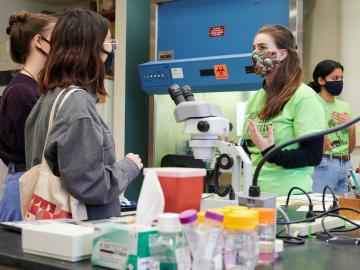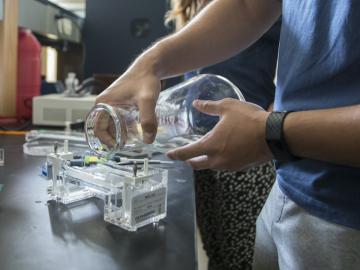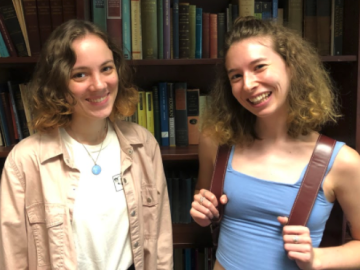Campus News
Senior Symposium 2015 Preview, Part 3
April 22, 2015
Communications Staff
The Office of the Dean of Arts and Sciences and the Office of the Dean of Studies invite all members of the campus and community to celebrate the academic and artistic endeavors of members of the Class of 2015 at the sixth annual Senior Symposium on Friday, April 24.
The symposium begins at 1 p.m. in Craig Lecture Hall with opening remarks from Tim Elgren, dean of the College of Arts and Sciences. Concurrent panels begin at 1:30 p.m., 2:45 p.m., and 4 p.m., and a reception in the Science Center Academic Commons will begin at 5 p.m.
This year, 70 seniors and fifth-years on 21 panels—the largest group to date—will each give a 12-minute presentation regarding work they performed for honors or capstones or research they conducted individually or with a faculty mentor.
To get a sense of the rich variety of topics covered at this year’s symposium, the Source is sharing a handful of project abstracts written by presenting seniors in the days leading up to the event. Learn more about the students included in today’s batch by clicking individual photos in the gallery above. See previously shared abstracts here (part 1) and here (part 2).
Taiyo Scanlon-Kimura, “Tracing the Language of Multiracialism in Postwar Japan”
Japan is often perceived as culturally, ethnically, and racially homogenous. In reality, diverse groups comprise Japanese society. Drawing from literature in anthropology and sociology, my capstone explores the presence of mixed-race Japanese, a relatively new class, following the end of World War II. Using terminology for multiriacials as a lens, I seek to define the contours of national identity: who has historically been allowed to be Japanese, who has not, and how conceptions of identity may change in the future.
Michael Stenovec, “The Politics of Narrative in Post-9/11 Conceptions of Justice”
How do we create meaning around traumatic events that rupture our descriptive abilities? Through the case of Jose Padilla, an American citizen detained as an enemy combatant in 2002, I explore the relationship between narratives of 9/11 and the construction of individual- and structural-based conceptions of justice. I use the work of Wittgenstein and Lyotard to locate the meanings of these conceptions within a broader context of linguistic contingency, but note that this approach does not explain how we make suffering meaningful. To compensate for this gap, I engage with the potential for 9/11 memorials to generate human meaning around catastrophe.
Amanda Strominger, “Competitive Facility Location”
In the optimization version of facility location, we look at how to place facilities in order to optimize some social cost function. In competitive facility location, we consider what happens when facilities are acting selfishly in order to win clients. There are many different variations of this game. We consider models in which clients are assigned to a facility based on distance. This class of models are called Voronoi games. Within this, there can be variations on whether the facilities take turns, how many players there are, and how they get to place facilities.
Daniel Stuff, “Investigating Filovirus Expression in Monodelphis domestica”
“Multivariate Method- Does Monodelphis domestica express Filovirus genes and in which tissues?” In this study, we explore the expression of a Filovirus nucleoprotein (NP) gene and a Filovirus RNA dependent RNA polymerase (L) gene in Monodelphis domestica. While we know these Filovirus genes are maintained within M. domestica’s genome, we do not know if they are expressed. Using primers specific to the NP and L gene, we extracted mRNA from various M. domestica tissues and attempted to see if any and how much amplification would occur using the primers for PCR.
Hannah Varadi, “Reconstructing Seville: A Translation and Contextualization of Capital Sur”
In this project, I compare modern translation theories with my own approach to translating Eduardo del Campo’s novel Capital Sur into English. I analyze the novel’s sociopolitical and historical context, showing Seville as a barometer of Spain’s economic and social collapse of the 1990s. I also examine how the novel’s modular narrative structure reflects the author’s reporting background, the stylistic influences of new journalism, and the Latin American biographical genre of the crónica. Finally, I demonstrate how we can use this novel to critically reexamine the hegemonic industry of translation publishing in the U.S.
Parkorn Wangpaiboonkit, “‘Oh, come è bello e morbido!’: Exposing the strangeness of Puccini's La Boheme
For the past century, Puccini’s La Boheme has existed comfortably in the popular operatic repertoire as an innocent love story of tragic loss, without much scholarly research to challenge this prevalent and often whitewashed interpretation. In my project, I take a critical look at the elements that surround La Boheme—its source novel, the opera itself, and its place in operatic history—to destabilize this pervasive understanding of the opera as a straightforward narrative of naive romance and youthful friendship. In doing so, I further explore the strangeness of this ever-popular opera by analyzing its nonconformity to the conventions of the Italian operatic repertoire and the verismo genre.
Will Watkins, “Four Lives in One: The Autobiographical Prose of Ruth Zernova”
This project focuses on the prose of Ruth Zernova (1919-2004), providing English translations of two of her short stories. Much of Zernova’s writing is autobiographical, with settings that range from her southern hometown of Odessa to prison camps in the far North. In order to make her stories more accessible to a western audience, I have provided commentaries which explain their historical and cultural contexts, as well as an introduction that discusses her life experiences and their impact on her writing. With these translations, I hope to highlight Zernova’s unique place as a Jewish woman author living in the Soviet Union during particularly challenging times.
Annie Winneg, “Promoting Systems Thinking through Metaphor”
Is income inequality more of a blemish or a failing organ in our economy? Both metaphors capture something about wealth disparities, but only "failing organ" seems to emphasize the fact that our economy is a complex system where activity in one region may lead to a cascade of problems in other parts of the system. With Professor Paul Thibodeau, I am studying variability in the extent to which metaphors highlight complex causal structure. I am interested in whether reading such metaphors can induce a systems thinking mindset and facilitate complex decision-making. This research has the potential to introduce metaphors as simple and scalable tools to help people approach some of the most difficult and complex problems we face today.
Tags:
You may also like…
Students Explore Oberlin’s Range of Research in This Year’s Lab Crawl
November 17, 2021
Lab Crawl was well attended this semester with many students making stops at demonstrations held in one or more of 22 labs across campus.
This Week in Photos: Alzheimer's Research
August 5, 2021
A picture of a student transferring an opaque substance into a gel box in a neuroscience lab serves as inspiration for this week’s photo series.
Emma Glen and Emily Hudson Publish Translations and Book Review
August 4, 2021
Third-years demonstrate artistry and command of language with translations of Latin poet Catullus.


